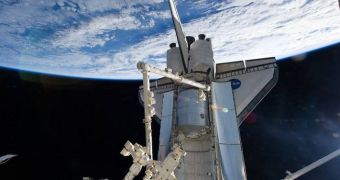The space shuttle will apparently be spending two full weeks in orbit, rather than 13 days, as it's usually the case. Experts at NASA Mission Control decided to extend this time frame in order to allow the seven-astronaut crew on the orbiter more time to use the orbital facility's main antenna for relaying back data on the status of their heat shield. Just after its launch, the shuttle experienced a glitch in its own antenna, which means that it can no longer transmit large batches of data. After the planned schedule of the STS-131 flight is completed, the joint crew will attempt to send out the Discovery data.
According to the renewed program, the orbiter is planned to land in Florida, at the Kennedy Space Center (KSC), on April 19. Flight managers for the new mission say that the decision was taken primarily to ensure that none of the other, main goals of the mission were jeopardized. Given that only three shuttle flights remain to be conducted by NASA after Discovery lands, it's essential that the crews manage to complete all of their alloted tasks. For this mission, Discovery astronauts still need to perform two additional extra-vehicular activities (EVA), Space reports.
They also have to move about eight tons of various supplies, spare parts and scientific experiments to the facility, while at the same time removing tons of trash and loading them on Discovery. As it stands, astronauts will be working non-stop on two fronts, NASA officials say. The extra day will also allow the crew on the orbiter to inspect their spacecraft's heat shield again. In addition, other tasks that would have otherwise taken a long time to complete will be done a lot faster. “It means that other crew members are available to do other things, and we've got a laundry list of activities that were normally planned to be done on the space station after Discovery left us,” Ed Van Cise, who is the flight director of the ISS, says.
“We can carry some of those forward, and having 13 people on board means we can get a few things done in a faster manner just by having more bodies available,” he adds. Thus far, a single EVA has been completed, which has seen a large and bulky ammonia tank being removed from Discovery's payload bay, and attached to a provisional location on the outer hull of the orbital facility. Over the next two spacewalks, astronauts will remove an old container from the ISS, place it in the orbiter, and then move the new ammonia tank in its final position.

 14 DAY TRIAL //
14 DAY TRIAL //